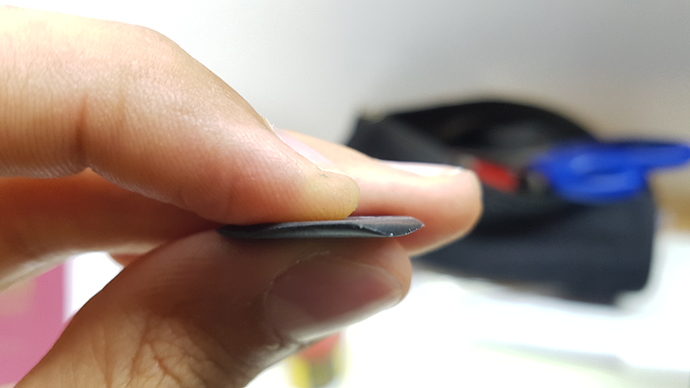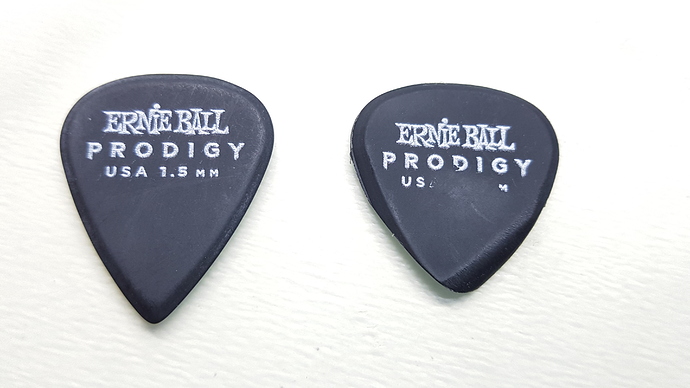So an abraded pick gives a db boost in certain frequency range as well!?
So the fresh (smooth) pick gets dents, and these dents are scraped across the strings, creating extra treble?
Or the (smooth) new pick with sharp edges gets rounded out, but remains smooth?
The word “abrasion” suggests that the edge becomes rough, and if one just scrapes it, one can hear a difference?
Cool stuff’! Quick blast on a nail file gives that awesome mini cello,swishy sound on the wound strings and super grip on the high strings!
Yes, if you take a sanding block and abrade a new Jazz III you will get the rough edge and the treble boost.
Keep in mind though tha nylon picks like the Jazz III often have a fringe of extra material at the bevel left over from the molding process. You can see this clearly if you hold it up to a light. This very thin fringe of material functions like edge abrasion and creates treble boost. But it wears away after a couple minutes of playing, leaving you with the non-abraded Jazz III.
Right - it’s a treble effect, >5khz
The Red Bear Guthrie Govan signature pick is coming out May 9th at 7am!
It’s $35 I think, but it has speed bevels is extra thick and a unique notched blunt edge used for weird Guthrie Govan sounds. And of course has the Red Bear signature grip holes too.
From what I’ve heard it’s the closest thing to real tortoise shell. I wonder how chirpy it is? 
I’d be interested to see test results on this and other boutique picks. 
Blue Chip picks essentially don’t wear out. They also provide the smoothest surface, with the least scratchy tones. I also have experimented with light polishing or sanding with very fine grit of regular picks when the edge gets sharp and the tone thins out. It works, if you can be bothered!
It would be interesting to see if the videos can capture different tone production. There is a huge difference in sounds you can get by the way you hold the pick and the motion mechanic, especially on acoustic guitar. With all this technology going toward improving speed and accuracy, how about a “look” at tone?
That is indeed what this section is about. It’s the “how” of how picks work. We do lots of comparisons, with frequency analysis, to understand how picks succeed in playing notes at all, and what does and does not make them sound the way they do. It isn’t even so much discovery of unknown stuff but more like an attempt to take what experienced players already know, put some numbers behind it, and present it in a way that is at least entertaining for beginners and experienced players alike.
Incidentally, is there any plan to do a similar analysis for string gauges? Seems to be a pretty big part of the proverbial equation.
Thanks Troy, I look forward to this series!
Just got through watching the new “Pick Design and Function” chapters, and the frequency response curves in the various comparisons were neat. Thing I found most interesting was the abrasion chapter. Might have to grab some of those Ibanez Elastomer picks to experiment with. And glad to see the Buck Rogers themesong make another appearance. 
Why the abrasion chapter?
I’ve noticed the difference in feel between abraded and non-abraded nylon picks (I mostly use the black stiffo Jazz III XL, and I tend to use a single pick for a long, long time). But I had never noticed (and it never occured to me) that there might be a significant difference in frequency response between an abraded and non-abraded pick. And the chirp discussion helped me better understand why I dislike the sound of thick Ultex picks (though I don’t mind the Ultex Sharp 1mm).
And I thought it was interesting that abrasion can result in a bump in high frequency overtones in an otherwise “dark” pickstroke (the “dark sparkle”, which BTW sounds like a great name for a “My Little Pony” villian.)
Ok we went with the abrasion chapter for the public YouTubeses:
The title is a little dramatic but the truth is, before I knew anything about picks or really even thought much about them, abrasion was probably the one characteristic of pick construction I remember that did matter. Once the Nylons got too scratchy, it was like getting sand in your shoe at the beach. As long the annoyance was at least evenly distributed, you could keep playing the pick. But if a big chunk goes missing, that’s like a rock in your shoe and then it was time to retire the pick.
@Troy Hi from Italy! Yesterday I saw your last video on youtube about picks abrasion and I found it really interesting. Now I’d like to share with you an experiment I did some months ago.
I bought the Ernie Ball Prodigy picks 1.5 mm and I didn’t find them confomrtable for my plating because of their sharp extremity even if I like the fact that they don’t consume. So I used a nail file to make some adjustements (see photo).
The first thing I noticed was that there was no friction between the pick and the strings at all, every pick stroke was effortless. I find this very positive but on the other hand this exaggereated filing eliminated all the high frequencies of the pick stroke and forced you to play with an obliged angle of 45°. I play metal so this is not a problem for me and I can get the high frequencies with the distortion, but for other styles or using a clean channel this may be unfavourable, or maybe you can find a very warm tone for slow and atmospheric arpeggios, it’s up to you!
Cheers


